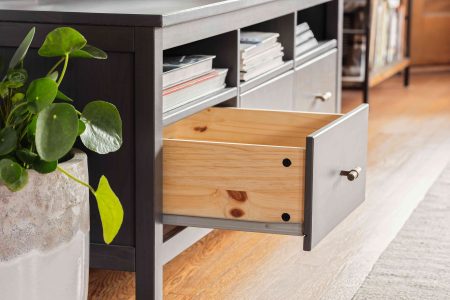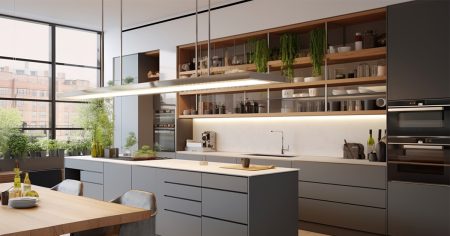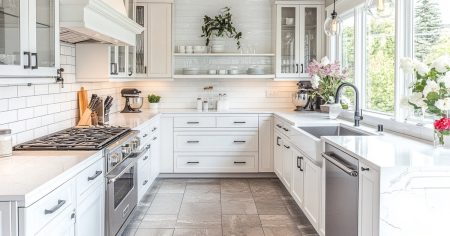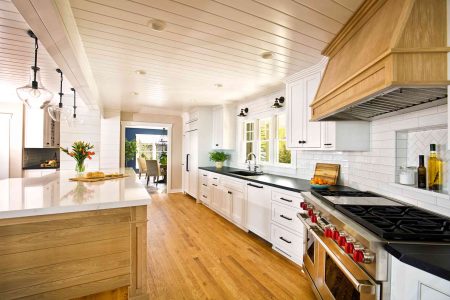Choosing the right kind of paint finish for a kitchen is important not only for aesthetics but because of the way the space is used. Areas like living rooms or bedrooms see less wear and tear, so more finishes can be used, even the hard-to-maintain flat finish. Kitchen walls and especially kitchen cabinets require a paint finish that’s tough, easy to wipe down, and attractive. Satin and eggshell paint finishes work well for kitchen walls, while semi-gloss proves best for kitchen cabinets.
Best Paint Finish For Kitchen Walls and Cabinets
Paint finishes for kitchen walls and cabinets do not need to match. It is common to use lower gloss paint on the walls and higher gloss paint on the cabinets. To match the finish on kitchen walls and cabinets, choose a satin or semi-gloss finish.
Kitchen Walls
Eggshell, satin, or semi-gloss paint finish works best on kitchen walls. Backsplash areas may benefit from semi-gloss or even high-gloss paint since they are likely to be scrubbed more often than other parts of the wall.
Kitchen Cabinets
Semi-gloss or glossy paint is typically used on kitchen cabinets or on woodwork such as door and window casings. The higher the gloss of paint, the more visible the paint brush marks. Try adding water or linseed oil, as appropriate, or use an oil-based paint. Spraying or rolling on the paint will eliminate brush marks, as well.
What Paint Finish Is
Paints for interior walls and woodwork come in several different finishes or sheens. Finish or sheen refers to the level of shininess or glossiness that is evident in the coat of paint when it is dried.
Paint finish, or paint sheen, makes kitchen walls and cabinets easier or more difficult to clean and maintain. Paint finish also determines the look of the kitchen. The paint’s shine is part of the gloss, but color is part of it, too. The higher the gloss of paint, the richer and brighter the color. Yet at certain angles, color may be lost with the higher gloss paints when light is reflected back at the viewer.
Each paint manufacturer has its terminology and means of categorizing the various sheen levels. In general, though, most manufacturers use a five-level classification to indicate the levels of finish: flat/matte, eggshell, satin, semi-gloss, and gloss or high-gloss.
Elements That Determine Paint Finish
Technically, paint finish or sheen levels are identified by the amount of light they reflect, and this is determined by three elements: resins, binders, and pigments.
Shinier, high-gloss paints contain relatively high levels of resins and binders that create a shiny, smooth, hard finish that reflects a lot of light. Paints with a higher ratio of pigments to resins and binders will be flatter in sheen and more susceptible to wear.
Because glossier paints contain less pigment and more binder, you may find it necessary to cover walls and woodwork with two or even three layers of paint to get complete coverage.
For many homeowners, this is a price well worth paying in a kitchen, where spills and splatters and other forms of heavy use will certainly mean that you’ll need to scrub the walls from time to time.
Differences Between Paint Finishes
Generally, paint manufacturers describe their different paint sheens as flat or matte, eggshell, satin, semi-gloss, and gloss or high-gloss.
Flat or Matte Paint Finish
A flat or matte paint provides a smooth, subtle, and almost velvety finish that camouflages imperfections. Flat or matte is ideal for low-traffic areas.
Flat paints diffuse light but tend to hold dirt and are more difficult to clean. The paint layer can be worn off with even minor scrubbing. Flat or matte paints are best suited for ceilings and walls in low-use rooms. Because flat or matte paint absorbs rather than reflects light, flat paints tend to hide wall imperfections.
Flat or matte paints in high-impact areas are difficult to clean. Often, the best way to clean a flat or matte paint finish is to repaint it. While this can be done quite easily with flat paint since it blends well, it’s not a viable option when used frequently. Some paint manufacturers offer scrubbable flat or matte paint.
Eggshell Paint Finish
An eggshell paint is a low-luster finish with similar merits to satin paints. Eggshell paints are slightly more scrubbable than flat paints and resist stains and scuffs better. An eggshell paint finish is suited for ceilings and walls in rooms that receive low to moderate wear.
Satin Paint Finish
A satin paint finish or sheen provides a versatile, elegant look that is perfect for more active rooms. A satin finish is an ideal multi-purpose paint for all walls in homes with children. It is a common choice for kitchen and bathroom walls.
Semi-Gloss Paint Finish
A semi-gloss paint finish can be scrubbed clean easily and has a sheen that reflects light. It can be used for high-traffic walls, such as found in hallways, and for woodwork. Though more often used for woodwork, semi-gloss is a viable choice for walls in high-use areas such as kitchens and bathrooms.
Gloss (High-Gloss) Paint Finish
Gloss or high-gloss is a very shiny finish that is ideal for rooms where frequent washing is likely. Not often used on walls, this finish is sometimes chosen for kitchen cabinets and woodwork, since it survives frequent and heavy washing without any wear. Some homeowners find gloss or high-gloss to be too shiny and industrial for use on walls. Extreme shininess can also expose flaws in walls.
Read the full article here









